
Water is essential for plant growth but plants vary greatly in their need for it. Since the amount of water on earth is finite but the demand is not, we must fine more efficient ways to use water. Plant selection is one of the ways to curb water use. Choosing plants whose needs are met by the conditions of the sites where they grow is the most successful approach for successful gardening no matter where you live. If you are uncertain about choosing plants consider where the plant grows naturally and compare its natural environment to yours. The closer the two are, the better the plant will do. For many gardens the use of extremely or very drought tolerant plants will reduce water use. Photo Credit: Ghislain 118 Wikimedia Commons
Blue flowers are treasured by gardeners because they are add a lot to the garden scene but are relatively scarce and make up only about 10% of the flower population. The color blue varies from clear sky blue to dark purplish blue and goes well with red, yellow, pink, orange and green. Blue and white, of course, is a classic! Blue brings serenity and calm to the garden and can be used cool down a hot border or, on the other hand, add a bit of pizzaz when judiciously combined with its complement, orange.
Here is a selection of blue, lavender and purple perennials and annuals that are considered very drought tolerant because they can live in areas that receive low rainfall annually or during the growing season. Adjustments have to be made, of course, for summer temperatures, humidity, and rainfall distribution, as local conditions dictate.
Mountain Bluet (Centaurea montana)
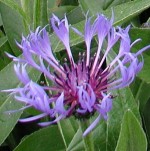
Also known as perennial bachelor’s button and montane knapweed, this clump forming herbaceous perennial is native to the upper montaine and sub-alpine zones of Europe where it grows in meadows and open woodlands. It is a member of aster family, Asteraceae, that also includes daisy, yarrow, and lettuce. Plants grow 18-24″ tall from a stoloniferous root system and have gray-green lower leaves that are lanceolate and up to 7″ long. In late spring to early summer unbranched stems carry solitary deep blue flowerheads that are 2-2.5″ wide and have reddish blue centers and black-edged involucre bracts. Flowers are attractive in the vase and plants are useful in xeriscapes, borders, cottage gardens, and meadow gardens.
Type: Herbaceous perennial
Height:18-24″
Bloom Time: Late spring to early summer
Light: Full sun
Hardiness: Zones 3-8
Photo Credit: Wikipedia
Mediterranean Sea Holly (Eryngium bourgatii)
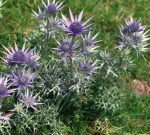
Native to Morocco,Lebanon, Turkey, France, and Spain, this rosette-forming herbaceous perennial is a member of the parsley family, Apiaceae, that also includes dill, celery, and Queen Anne’s lace. It grows 1-2′ tall from a taproot and has stiff well branched stems bearing palmately divided gray-green leaves that are up to 2 inches long and have silvery white veins. From mid summer into fall, terminal flowerheads appear that are up to 1″ across and 3/4″ long. Each flowerhead consists of a cone-shaped structure bearing tiny blue-green to silver-blue flowers and is subtended by long silvery bracts up to 2″ long. The plants are tolerant of lean soil and drought and are a good choice for a xeriscape, border, and rock, cottage, and cutting gardens. The flower heads add both texture and form to fresh and dried arrangements.
Type: Herbaceous perennial
Bloom: Flower heads with tiny blue-green to silver-blue flowers, subtended by long silvery white bracts; from mid summer into fall
Height 1-2’H
Bloom Time: Mid summer into fall
Light: Full sun; tolerates some shade but best color is in full sun (with cool temperatures)
Hardiness: Zones 3-8
Photo Credit: Wikipedia
Hyssop (Hyssopus officinalis)
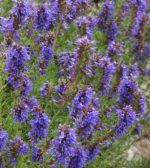
Hyssop is a small semi-evergreen subshrub up to 24″ tall, native to southern Europe, the Middle East, and the area around the Caspian sea but has naturalized in parts of the US. It has a woody base and a number of many branched upright square stems carrying shinny, dark green, lanceolate leaves that are toothed, stalkless, aromatic and up to 1″ long. The 2-lipped, tubular, fragrant flowers are blue to violet and have protruding stamens. They appear in whorls on terminal spikes from mid- to late summer and are attractive to bees, butterflies and hummingbirds. For centuries hyssop has been used as a medicinal, culinary and ornamental herb, and its volatile oil is used in some liqueurs including Benedictine and Chartreuse. Hyssop is an attractive plant for a border, a knot garden, herb, butterfly, bird, or rock garden.
Type: Semi-evergreen subshrub
Height: 1.5-2′
Bloom Time: Mid to late summer
Light: Full sun with afternoon shade in the South
Hardiness: Zones 4-9
Photo Credit: Wikimedia
Globe Amaranth (Gomphrena globosa)
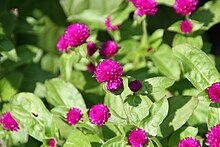
Native to Texas and Mexico, this annual grows 1-3′ tall, depending on the cultivar, and has stiff branching stems and lanceolate leaves that are 3-4″ long, slightly hairy, and almost sessile. The globose flowerheads are up to 1.5″ across and consists of colorful papery petal-like bracts and relatively few tiny yellow flowers. The bracts may be white, lavender, pink, red or magenta. Plants flower all summer long and each flowerhead has a long bloom time. The flowerheads are good in fresh or dried arrangements.
Type: Annual
Height: 1-3′
Bloom Time: Summer into fall
Light: Full sun
Hardiness: Not hardy
Photo Credit: Wikipedia
Dotted Gayfeather (Liatris punctata)
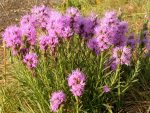
Also known as dotted blazingstar and narrow-leaves blazingstar, this herbaceous perennial is native to the central plains of the US from Canada to northern Mexico. It is a member of the aster family, Asteraceae, that also includes daisy, yarrow, and lettuce. Plants grow from a tap root up to 16′ long and produce one or more erect unbranched stems 12-24″ tall. The stems carry densely packed, narrow, grass-like leaves that have short white hairs on the margins and are covered with dots of resin. The leaves are up to 4′ long at the base of the plant, getting smaller as they ascend. In summer, 6-20″ long terminal spikes of pink, purple or white flowerheads appear on each stem. Each flowerhead consists of 3-8 star-shaped disc flowers 3/4″ long and is surrounded by a involucre of green to purplish bracts . Unlike most spikes, the flowers open from top to bottom. Dotted gayfeather is long lived and with its deep tap root is very drought resistant. In addition, the plant is fire tolerant and can resprout from its rhizomes. Plants are attractive in mixed border and the flowering stems are good in both fresh and dried arrangements. A good choice for a xeriscape as well as meadow, native plant, wildflower, and cutting gardens.
Type: Herbaceous perennial
Height: 12-14″
Bloom Time: Summer
Light: Full sun; tolerates some shade
Hardiness: Zones 4-10
Photo Credit: Wikipedia
Perennial Flax (Linum perenne)
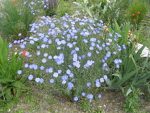
Native to Europe, this semi-evergreen short-lived perennial is a member of the flax family, Linaceae, that includes 250 species. It grows 1-2′ tall from a deep taproot and has thin wiry unbranched stems bearing spirally arranged, lanceolate gray-green leaves that are up to 1.5″ long and usually droop downward. From late spring to mid summer, terminal clusters of up 10 nodding buds appear and open to flowers that are 3/4-1″ wide and have 5 sky blue petals with dark blue veins. Although each flower opens only once from morning until noon the number of flowers produced at any given time is so abundant a good display results. Plants are tolerant of drought, heat and humidity but are short lived, although they often reseed. They are valuable in borders and xeriscapes as well as in cottage, meadow, prairie, Mediterranean, and rock gardens, especially when massed.
Type: Semi-evergreen short-lived perennial
Height: 1-2′
Bloom Time: Late spring to mid summer
Light: Full sun to partial shade
Hardiness: Zones 5-8
Photo Credit: Wikipedia
Wild Bergamot (Monarda fistulosa)
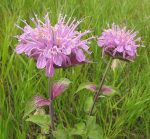
This wildflower is native to North America where it grows in prairies, dry rocky woods, tickets, and abandoned areas in most of the US. I is a member of the deadnettle family, Lamiaceae, that also includes mint, sage, and cat——+nip.With a deep root system and creeping rhizomes, plants form clumps 3-4′ tall and 2-3′ wide and have several erect square stems carrying lanceolate grayish-green leaves that are 2-3″ long, aromatic, and have toothed margins. For several weeks in summer, terminal clusters of 20-50 two lipped, tubular pink to lavender flowers appear. The clusters are 1.5″ long and subtended by a whorl of pinkish bracts. The flowers attract pollinators including bees, butterflies, and hummingbirds and are attractive in fresh and dried arrangements . Native Americans used the plant medicinally and the leaves can be used to make tea. The plant is a good choice for a xeriscape and cottage, native plant, wildflower, butterfly, wildlife, meadow, herb and cutting gardens.
Type: Herbaceous perennial
Height: 3-4′
Bloom Time: Long bloom time in summer
Light: Full sun; tolerates shade
Hardiness: Zones 3-9
Photo Credit: Wikimedia
Five Spot (Nemophila maculata)
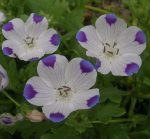
Also known as five-spot baby or buffalo eyes, this trailing annual is endemic to California where it grows primarily in meadows and woodlands of the Sierra foothills. It is a member of the borge family, Boraginaceae, that also includes forget-me-not, Siberian bugloss, and lungwort. The hairy, bushy plants grow 4-10″ tall and have pinnately lobed leaves that are up to 1″ long. From spring to mid summer, terminal bell-shaped flowers appear that are up to 2″ in diameter and have five white petals, each with bluish to purple veins and spot at the tip. The spots attract their primary pollinators, solitary bees. The fruits contain 12 greenish brown seeds and plants reseed readily. Five spot does best in cool weather and if grown with sun in the morning but shade in the afternoon. It is a good choice for a groundcover especially over bulbs, as well as for cottage, wildflower, wildlife or meadow gardens.
Type: Annual
Height: 4-10″
Bloom Time: Spring to mid-summer
Light: Full sun with afternoon shade
Hardiness: Not hardy
Photo Credit: Wikimedia Commons
Rocky Mountain Beard-Tongue (Penstemon stricta)
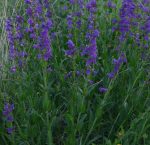
Rocky Mountain beard-tongue is a semi evergreen perennial native to western US from southern Wyoming and western Colorado to northeastern Arizona and northern New Mexico, with an isolated population in east central California. With a fibrous root system, plants grow 1-3′ tall and form a dense mat of foliage with several stems. The leaves are long and narrow with the basal ones being longer than those on the stems. In spring, spikes of royal blue to purple flowers .75-1.50″ long rise above the mat of foliage. The tubular flowers are two lipped; the upper lip is two lobed and projects over the lower, three-lobed lip. Butterflies and beneficial insects find the flowers attractive. Plants are valued as ornamentals for the garden and are especially good in dry areas of the country.
Type: Semi evergreen perennial
Height: 1-3′
Bloom Time: Spring
Light: Full sun but tolerates light shade
Hardiness: Zones 3-8
Photo Credit: Wikipedia
Creeping Rosemary (Rosmarinus officinalis ‘Prostratus’)
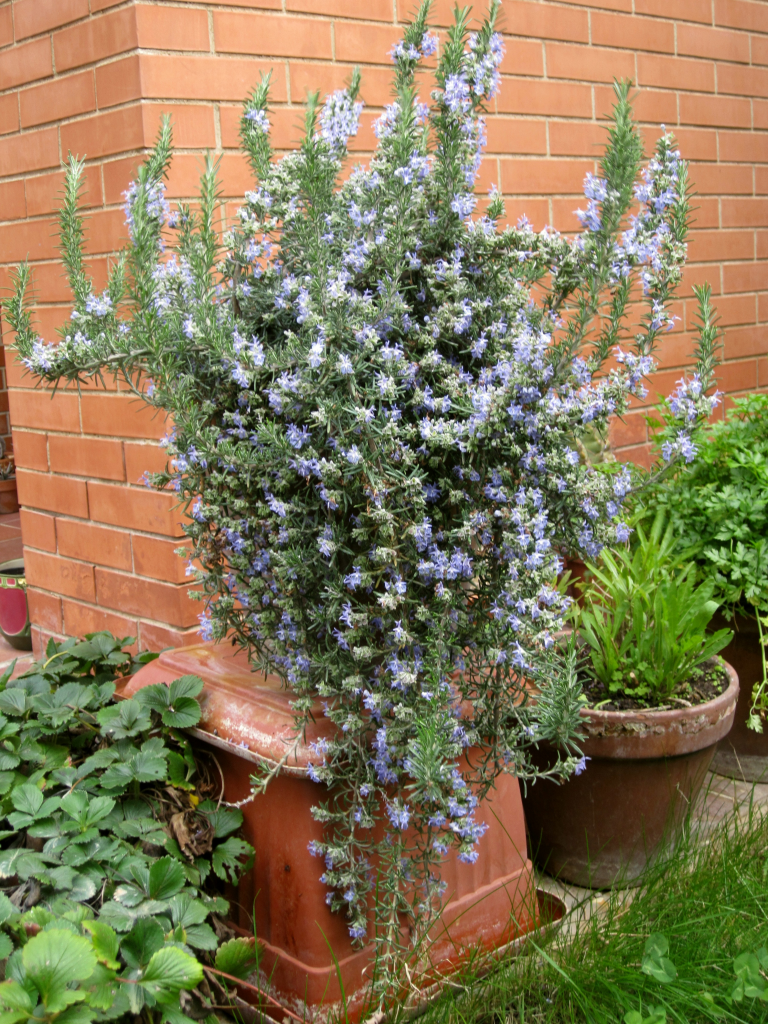
This low growing, spreading evergreen shrub is a cultivar of a plant native to the Mediterranean and a member of the deadnettle family, Lamiaceae, that also includes beebalm, basal, and lavender. It grows 6-24″ tall and up to 4′ wide, rooting as it spreads. The needle-like leaves are grayish green with whitish undersides and up to 2″ long. They have a pine-like scent and are valued as a culinary herb fresh or dried. From spring into summer, clusters of small pale blue to white tubular flowers appear that are attractive to both butterflies and bees. Creeping rosemary is valued for its use as a groundcover, in containers and window boxes, and in Mediterranean, wall, rock, herb, and xeric gardens.
Type: Evergreen shrub
Height: 6-24″
Bloom Time: Spring into summer
Light: Full sun; tolerates some shade
Hardiness: Zones 8-10
Photo Credit: Petar 43, Wikimedia Commons